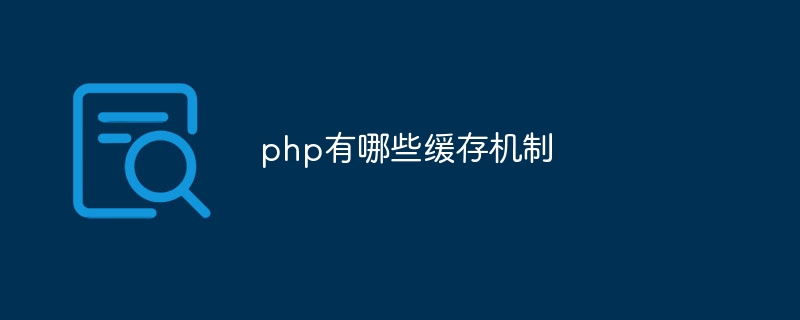Home >Backend Development >PHP Tutorial >What caching mechanisms does php have?
php caching mechanisms include Opcode cache, data cache, page cache, database query cache, distributed cache, cache plug-in, metadata cache, cache strategy, cache hit and failure, compression and encoding, etc. Detailed introduction: 1. Opcode caching. Opcode is an intermediate code representation of PHP code. It can be cached before execution to improve execution efficiency; 2. Data caching. PHP provides a variety of data caching mechanisms, including variable caching and memory. Caching and file caching; 3. Page caching, which is to cache the entire Web page and so on.

The operating system of this tutorial: Windows10 system, PHP version 8.1.3, DELL G3 computer.
PHP is a popular server-side programming language widely used in web development. To improve performance and responsiveness, PHP provides a variety of caching mechanisms. The following are the main contents of the PHP caching mechanism:
1. Opcode caching: Opcode is the intermediate code representation of PHP code, which can be cached before execution to improve execution efficiency. Some popular Opcode caches include APC (Alternative PHP Cache), XCache, and eAccelerator. These caches compile PHP code into Opcode and store it in memory for direct execution on subsequent requests without needing to compile it again. This can significantly reduce the execution time of PHP scripts.
2. Data caching: PHP provides a variety of data caching mechanisms, including variable caching, memory caching and file caching. Variable caching is storing data in session or global variables for reuse in subsequent code executions. In-memory cache stores data in memory, usually using third-party cache extensions (such as Memcached or Redis). File caching is storing data in files that can be read and written when needed.
3. Page caching: Page caching saves the entire web page in a static file so that the file can be provided directly in subsequent requests. This method is suitable for static pages with infrequent content updates, such as home pages, article pages, etc. By caching pages as static files, you can reduce requests to the server and improve the performance of your web application.
4. Database query cache: For PHP applications that use databases, database queries are usually one of the performance bottlenecks. In order to improve query efficiency, PHP provides a database query caching mechanism. This mechanism stores query results in memory for reuse in subsequent queries. Some database extensions (such as MySQL's Memcached extension) provide built-in query caching capabilities.
5. Distributed cache: Distributed cache caches data on multiple servers to improve scalability and fault tolerance. Some popular distributed caching solutions include Redis, Memcached and Cassandra. These solutions can store data on multiple nodes and provide high availability and scalability.
6. Caching plug-ins: In addition to the built-in caching mechanism, there are also some third-party caching plug-ins to choose from. These plugins can be integrated with common frameworks and libraries such as Memcached, Redis, APC, etc. These plugins provide more flexibility and scalability and can be customized to specific needs.
7. Metadata cache: Metadata is data that describes data, such as column names, types and constraints of database tables, etc. PHP provides a metadata caching mechanism to store metadata in memory for quick access when needed. This can reduce the number of queries to the database or other data sources and improve application performance.
8. Caching strategy: Different caching strategies can be selected according to different application requirements and scenarios. Common caching strategies include least recently used (LRU), least frequently used (LFU), etc. These policies can determine which entries should be replaced or eliminated based on factors such as frequency of access, resource size, resource type, and more.
9. Cache hit and failure: When requesting the same resource, if the resource is already available in the cache, the resource can be obtained directly from the cache instead of sending a request to the server. This is called a cache hit. Conversely, when the requested resource is not in the cache, a request needs to be sent to the server to get the latest resource. At this point, the resource will be added to the cache for reuse on subsequent requests.
10. Compression and encoding: PHP supports compression and encoding of responses, such as Gzip compression, Deflate compression, etc. These techniques can reduce the size of responses, thereby reducing network transfer time and bandwidth consumption. At the same time, the client can also decode and decompress the response for local use.
To sum up, PHP provides a variety of caching mechanisms to improve performance and response speed. These mechanisms include Opcode caching, data caching, page caching, database query caching, distributed caching, cache plug-ins, metadata caching, caching strategies, cache hits and invalidations, and compression and encoding. Choosing an appropriate caching mechanism based on specific business needs and scenarios can help developers optimize the performance and response speed of PHP applications.
The above is the detailed content of What caching mechanisms does php have?. For more information, please follow other related articles on the PHP Chinese website!